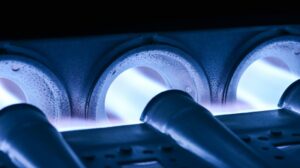If you’re like many of the homeowners throughout the areas we serve, you are using a gas-powered furnace to heat your home and keep your family warm. A furnace is a fantastic choice–it’s powerful and cost-effective. Today’s furnaces have a much higher minimum efficiency rating than even just 10 years ago, with the highest AFUE (Annual Fuel Utilization Efficiency) rating for a gas furnace being 98%!
Trust us when we say that a gas furnace is a very efficient and effective heater. But you also want to rely on safety, right? And gas furnaces aren’t inherently unsafe, but if you don’t maintain yours properly, it can become dangerous.
Though more common in aging furnaces (10-15 years old), the most common culprit of “danger” in a gas furnace is a damaged heat exchanger. That said, even if you don’t have a heat exchanger problem, it’s probably a good idea to start looking at replacement options if your furnace has reached this age–it will start to suffer from other wear and tear.
In the meantime, no matter how old your furnace is, you should know what’s so important about the heat exchanger, and why a damaged one is bad news. Read on!
So, What’s a Heat Exchanger?
Excellent question! This is component isn’t just important to the operation of your gas-powered furnace, it’s essential. The heat exchanger is the component where the heat from combustion gases collects to heat up the metal walls so that air can pass over them, bringing heat into your home. In other words, the heat exchangers are part of the furnace that is actually responsible for bringing warmth into your home.
The combustion gases enter a clamshell-shaped chamber that makes up your heat exchanger. The gas increases the temperature of the metal walls, and the blower fan of your furnace pushes air over the heat exchanger and into your home. That air then travels through your air ducts and through the vents in each room of your living space. The metal walls of the heat exchanger, then, are the only thing that stands between your indoor air and the combustion gases.
Why You Don’t Want a Damaged Heat Exchanger
Over the years, natural wear and tear will impact your furnace, and this includes the heat exchangers. Every time the heat exchangers get hot, their metal walls expand. They contract as they cool down. After years of this, they are susceptible to corrosion and subsequent cracks.
When we say cracks, we’re talking about extremely small microfissures in the metal walls. However, when the heat exchangers heat up again they expand, opening up these cracks and allowing combustion gas to leak out. When a furnace is properly ventilated, this may not be a problem. But there is one combustion gas in particular–CO, or carbon monoxide–that can be very harmful if it does make its way into your indoor air.
For professional maintenance or to schedule heating repair in Brentwood, TN, look no further than Covenant Heating and Cooling. Contact us today!

